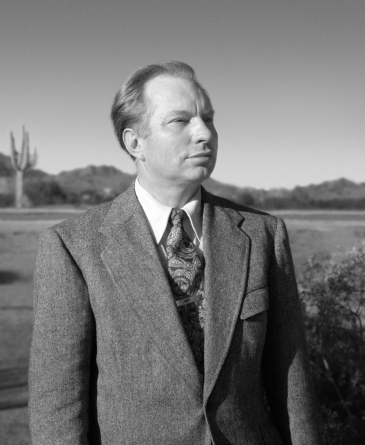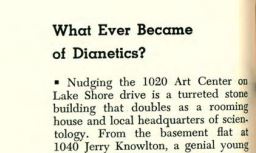Previously, our tipster who searches through old newspaper clippings found for us a rare interview of L. Ron Hubbard that took place in Tunisia in 1968. One of our favorite revelations in that interview was that Hubbard didn’t deny that he’d claimed to have made trips to “Heaven.”
This time, our archives wrangler found another interesting item, from an earlier era. It was June 1954, and Chicago magazine ran an unbylined piece about visiting some local Scientologists as they went through processing at the local org.
As the writer points out, it had been a few years since Dianetics had exploded on the scene in 1950, and then had just as suddenly faded away. What had become of it?
What the writer apparently didn’t know was that L. Ron Hubbard had been through a horrendous 1951, as his second marriage, to Sara Northrup, fell apart, the Dianetics craze died out, and his foundations went broke. He even absconded to Cuba with Alexis, the baby he and Sara had had in 1950.
Eventually, after giving Alexis back to Sara and then getting a divorce, Hubbard had regrouped in Wichita and then Phoenix, giving himself a new start with something he now called “Scientology.”
In 1954, Scientology was gradually growing when this piece was published. It offers a fun snapshot of that period. We’ll be interested to hear from our experts what they find surprising here for that era. And thank you again, tipster!
What Ever Became of Dianetics?
Nudging the 1020 Art Center on Lake Shore drive is a turreted stone building that doubles as a rooming house and local headquarters of scientology. From the basement flat at 1040 Jerry Knowlton, a genial young man with a shaggy crew cut, superintends the movements of a study he has followed since its embryonic days as dianetics. He took time to expound in dianetics, scientology, and his connection with both, before a regular Sunday processing, or session of therapy, got under way. Several people were coming, he explained, group therapy being much favored by the founder of scientology, Lafayette Ron Hubbard.
The central idea in this system of mental health, said Knowlton, is that “life is basically a non-moving static: the ‘thetan’ or soul of each person mirrors all experience and is a high-frequency generator of thought wave-patterns.” By pursuing these waves back to very early painful experiences (all the way back to conception in some cases) the patient, or processee, obtains release and thus is cured. Self-treatment, however, is tedious; usually the subject is paired with a more advanced student, and mutual processing ensues.
“It’s much more inclusive than dianetics,” said Knowlton, the waves of his plaid jacket squiggling up and down as he paced. “New ideas are being added all the time.” Hubbard himself disbanded his original dianetics school shortly after he published the definitive work in 1950. Scientology, Hubbard now feels, offers a broader base for dealing with personal problems.
Knowlton interrupted his account to welcome a guest, both processor and processee, in the ample person of a college music teacher. She loomed into the room, greeted him jovially, lowered herself into a chair, and joined with interest in the conversation. Dianetics originally attracted her as a means of improving her memory, she said.
“Now I’ve got very good color imagery, and I’m working toward eidetic recall.” (This is a faculty similar to photographic memory, including all the other senses as well).
Knowlton was not disposed to demonstrate eidetic recall, but he did summon up a recollection of his first meeting with Hubbard. It was in 1947, when he was working in the East on a betatron project for General Electric. As a former physics student (University of Chicago) and amateur in science-fiction, he was familiar with such books of Hubbard’s as Final Blackout and Death’s Deputy.
“Some of the best,” he murmured nostalgically.
Hubbard is a former civil engineer who had served in the navy during the war. The threat of atomic destruction set him brooding upon a way to survive, and he believed he discovered it in dianetics.
“Actually the idea goes back to Buddha and Pythagoras, and even earlier. The yogis knew about it too.” Old as this idea is, Knowlton feels that Hubbard’s formulation is masterful. He learned to audit (the same as process) from him, and after three training courses received a bachelor’s degree in scientology, its later form, in 1952. Now he divides his time between therapy and occasional jobs (the last at Northwestern University).
There are at least three other groups and centers scattered thruout the city, and probably two to three hundred persons in treatment. Owing to the unique chain effect of scientology (where A co-audits with B, who in turn co-audits with C), the number increases rapidly. Fees range from nothing at all to five or ten dollars a session, which can last an hour or longer, if need be. “We often spend the whole afternoon and evening here,” said Knowlton.
“He’d rather audit than eat,” said the music teacher. At the mention of food, Mrs. Knowlton slipped quietly out of the background. She uncurled her legs from a rapt position at the end of the couch, shook out her blonde pony tail and got up to put a kettle on the stove. Her husband explained that she had married into scientology only last fall.
A medium-sized, dark-haired woman arrived at this point with her little boy. She had brought along some pralines for tea, and talk veered toward the dietetic in dianetics.
“I find that when I’m being processed I use a lot of energy,” said the music teacher. “I’ve noticed that it affects my teeth.”
“Depletes the calcium,” replied the mother of the little boy, who was crayoning a picture book. “That’s why Dr. Hubbard advises vitamins.”
In England, she continued, where teachers were being trained in scientology, they found that processed children had fewer colds, almost no cavities, and some even stopped wearing glasses. “They’ve noticed an improvement in their I.Q., too.”
Great Britain is by no means the farthest outpost of this movement. Knowlton revealed centers as far away as Tel Aviv and Johannesburg, started by the peripatetic followers of Hubbard. Hubbard himself has just returned from a year and a half abroad, where he met with greater enthusiasm for his ideas than in this country.
“That’s because Americans are afraid of anything to do with psychiatry,” said the mother of the little boy, who was now blowing bubbles with Knowlton.
Did scientology, then, owe anything to psychiatry?
“Definitely,” she said. “Horney and Rogers were on the right track, but they didn’t go far enough.” She did not elaborate. Knowlton spoke up.
“Freud put too much emphasis on sex, and those who came after him only made it worse.”
Were there any splinter groups in the movement? “Well, there’s Dr. Winter [J.A. Winter, M.D., who wrote the introduction to Dianetics and later sold his practice in Michigan to do auditing in New York]. He’s been restimulating birth and other trauma by using carbon dioxide and methedrine.” Methedrine, he explained, was a preparation that lessened the sense of fatigue and produced a feeling of elation. “Hubbard doesn’t believe in using drugs. They take away the person’s self-determination.”
“And then there’s the Wichita group,” ventured the music teacher. “They’ve become too structuralized.”
Structuralization, an organizational hardening of the arteries, means a refusal to accept new findings and presents the greatest danger to the movement. That is why Hubbard is continually disbanding one group and forming another.
“He’s not at all interested in building up his own power,” said the mother of the little boy, who was fiddling with her purse.
Neither she nor any of the others seemed particularly worried about defection among former supporters. Nor did they look upon their task as one of recruitment.
“Unless a person really wants to be processed, it won’t do him any good,” said the music teacher. She told of an Armenian faith healer who had attracted hundreds of followers at a Florida resort where she was staying a few years ago.
“People will sometimes show up like that, expecting a miracle.” She sighed.
“My, don’t we sound conservative!” said the mother of the little boy, who came and put his head in her lap.
——————–
One year ago today
Andrea Garner has reminded us what was happening one year ago today, when we joined her and Pete Griffiths for a pre-show dinner before heading over to the worldwide premiere of Louis Theroux’s film, My Scientology Movie, at the London Film Festival.
After a post-show drink with Theroux, we went back to our hotel and stayed up late to hammer out our thoughts about the film. Now, a year later, it’s in theaters, and we are enjoying the reviews that readers have been posting in our comments. It’s really a funny movie, and Louis is getting a ton of well-deserved press.
——————–
 Posted by Tony Ortega on October 14, 2016 at 07:00
Posted by Tony Ortega on October 14, 2016 at 07:00
E-mail tips and story ideas to tonyo94 AT gmail DOT com or follow us on Twitter. We post behind-the-scenes updates at our Facebook author page. After every new story we send out an alert to our e-mail list and our FB page.
Our book, The Unbreakable Miss Lovely: How the Church of Scientology tried to destroy Paulette Cooper, is on sale at Amazon in paperback, Kindle, and audiobook versions. We’ve posted photographs of Paulette and scenes from her life at a separate location. Reader Sookie put together a complete index. More information about the book, and our 2015 book tour, can also be found at the book’s dedicated page.
Learn about Scientology with our numerous series with experts…
BLOGGING DIANETICS: We read Scientology’s founding text cover to cover with the help of L.A. attorney and former church member Vance Woodward
UP THE BRIDGE: Claire Headley and Bruce Hines train us as Scientologists
GETTING OUR ETHICS IN: Jefferson Hawkins explains Scientology’s system of justice
SCIENTOLOGY MYTHBUSTING: Historian Jon Atack discusses key Scientology concepts
Other links: Shelly Miscavige, ten years gone | The Lisa McPherson story told in real time | The Cathriona White stories | The Leah Remini ‘Knowledge Reports’ | Hear audio of a Scientology excommunication | Scientology’s little day care of horrors | Whatever happened to Steve Fishman? | Felony charges for Scientology’s drug rehab scam | Why Scientology digs bomb-proof vaults in the desert | PZ Myers reads L. Ron Hubbard’s “A History of Man” | Scientology’s Master Spies | Scientology’s Private Dancer | The mystery of the richest Scientologist and his wayward sons | Scientology’s shocking mistreatment of the mentally ill | Scientology boasts about assistance from Google | The Underground Bunker’s Official Theme Song | The Underground Bunker FAQ
Our Guide to Alex Gibney’s film ‘Going Clear,’ and our pages about its principal figures…
Jason Beghe | Tom DeVocht | Sara Goldberg | Paul Haggis | Mark “Marty” Rathbun | Mike Rinder | Spanky Taylor | Hana Whitfield









